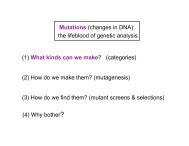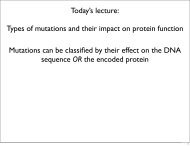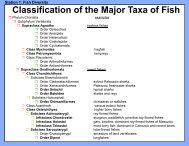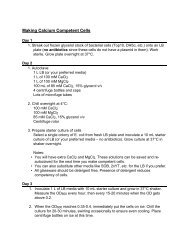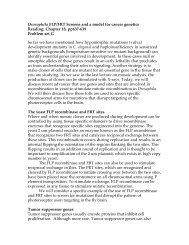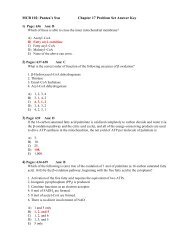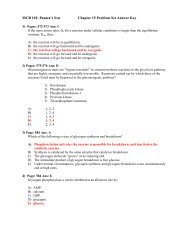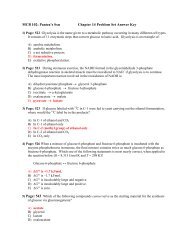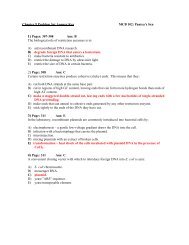LECTURE 12: CHANGES IN CHROMOSOME NUMBER Reading ...
LECTURE 12: CHANGES IN CHROMOSOME NUMBER Reading ...
LECTURE 12: CHANGES IN CHROMOSOME NUMBER Reading ...
Create successful ePaper yourself
Turn your PDF publications into a flip-book with our unique Google optimized e-Paper software.
<strong>LECTURE</strong> <strong>12</strong>: <strong>CHANGES</strong> <strong>IN</strong> <strong>CHROMOSOME</strong> <strong>NUMBER</strong><br />
<strong>Reading</strong>: Ch. 13, p. 466-476; Fig. 4-16<br />
Problems: Ch. 13, 13-27 – 13-29, 13-31, 13-32, 13-34 – 13-36<br />
Announcements: See homepage for announcements regarding the exam.<br />
Last time, we talked about how aneuploids (aneuploid = organism in which a particular<br />
chromosome or chromosomal segment is over- or under-represented) can be generated by<br />
chromosomal rearrangements. Today, we'll talk about aneuploidy at the level of whole<br />
chromosomes and we'll talk about species whose genomes contain complete (but nondiploid)<br />
sets of chromosomes.<br />
DEF<strong>IN</strong>ITIONS:<br />
Ploidy: number of basic chromosome sets (a diploid has 2 sets; a hexaploid has 6 sets)<br />
Euploid: organism containing multiples of the basic chromosome set<br />
Monoploid: organisms with one chromosome set (in essentially diploid taxa)<br />
Polyploid: organism containing more than two chromosome sets<br />
Basic chromosome number, x (also called monoploid number): the number of different<br />
chromosomes that make up a single complete set. (In a diploid organism with 10 pairs of<br />
chromosomes, x = 10)<br />
Haploid number, n: number of chromosomes in the gametes<br />
(In diploid organisms n=x, but this is not true for polyploid species. Wheat is a hexaploid with 42<br />
chromosomes; in this case x=7 and n=21.)<br />
Allopolyploids: polyploids created by hybridization between different species (homeologous<br />
chromosomes)<br />
Autopolyploids: polyploids created by chromosome duplication within a species<br />
Most euploid species are diploids. There are a few examples of monoploidy. For example, in<br />
some species of bees, wasps, and ants, the females are diploid and males are monoploid. The<br />
males develop parthenogenetically from unfertilized eggs, thus receive a haploid set of<br />
chromosomes from their mothers. Males can produce gametes using a modified mitosis.<br />
Monoploids can also be made artificially in some species. For example, geneticists generate<br />
haploid embryos because genotype in haploids is revealed by phenotype. We discussed how<br />
haploid zebrafish can be used in genetic screens. Haploid plants can also be used to select for<br />
recessive mutations that confer resistance to chemicals or pathogens. Haploid pollen grains are<br />
treated and plated onto agar plates. The haploid embryoids that result are treated with hormones<br />
to allow regeneration of a monoploid plant. Somatic cells from a monoploid plant are treated<br />
with mutagen and then plated onto agar containing the selective agent. The only cells that can<br />
generate embryoids and thus resistant monoploid plants are those resistant to the selective agent.<br />
The others die. Somatic cells from resistant monoploid plants are then treated with colchicine to<br />
block formation of the mitotic spindle and block cytokinesis, thereby allowing the cells to<br />
become diploid. Upon proper hormone treatment, the cells can develop into a diploid<br />
homozygous resistant and fertile plant.<br />
There are a few examples of polyploidy in animals. It is rare probably because it interferes with<br />
sex-determination. Usually, polyploid animals have unusual reproductive cycles. Flatworms,<br />
leeches, brine shimps, some salamander and lizards, and goldfish are parthenogenetic. Triploid
oysters have no sexual cycle (hence, no mating season when oysters are usually unpalatable!)<br />
Some polyploid amphibians (some frogs and toads) do use sexual reproduction.<br />
Polyploidy is much more common in plants! Roughly one of three known species of flowering<br />
plants are polyploids. One-half of all known plant genera contain polyploid species and 2/3 of all<br />
grasses are polyploid. Examples are wheat (6x), alfalfa (4x), coffee (4x), peanuts (4x),<br />
strawberries (8x), and cotton (4x). Ornamentals such as roses, chrysanthemums, and tulips are<br />
also polyploid. Polyploidy is often associated with larger cells (because the nucleus is larger),<br />
and polyploids tend to be larger and more robust.<br />
Some plant polyploids reproduce asexually because they are sterile. This is due to irregular<br />
segregation during meiosis, leading to aneuploid gametes. Triploidy is almost always sterile<br />
(bananas are propagated by cuttings, some apple species by grafts, and other species by bulbs).<br />
Triploids are often formed by fusion of a diploid (2x) gamete from a tetraploid (4x) parent with a<br />
normal gamete from a diploid parent. If x is large, you can imagine that meiosis would rarely<br />
result in balanced gametes; instead the gametes contain somewhere between x and 2x<br />
chromosomes. Because of the sterility, triploids rarely make seeds (recall a banana or seedless<br />
watermelon you ate recently). Remember the triploid oysters above.<br />
Some tetraploids can provide viable offspring. Maintenance of a fertile tetraploid organism<br />
depends upon whether the plant can produce gametes with balanced sets of chromosomes. How<br />
are tetraploids usually generated?<br />
Generation of Autopolyploids (polyploids created by chromosome duplication within a species):<br />
In diploid plants, sometimes sister chromatids fail to separate during mitosis, leading to<br />
tetraploid daughter cells; if these tetraploid cells give rise to reproductive tissues, then diploid<br />
(instead of haploid) gametes will be produced. A rare union of diploid gametes gives rise to a<br />
tetraploid individual; if this individual can self-pollinate, then a whole new species may arise.<br />
Autopolyploidy can also be induced artificially with colchicine.<br />
Generation of Allopolyploids (polyploids created by hybridization between different species):<br />
Allopolyploids are generated by hybridization between two related species. The hybrid is sterile<br />
since the chromosomes (which can differ in shape, size, and number) cannot pair and segregate<br />
properly during meiosis. However, sometimes chromosomal doubling occurs, restoring fertility<br />
since doubling creates a proper pairing partner for each chromosome. If the two parental species<br />
are diploid, the resulting allopolyploid is called an amphidiploid. Meiosis is regular in<br />
amphidiploids because each chromosome now has a pairing partner, producing euploid gametes<br />
that can combine to allow normal sexual reproduction.<br />
MORE DEF<strong>IN</strong>ITIONS:<br />
Aneuploid: Individuals have a numerical change in part of the genome. The chromosome<br />
number of aneuploids is not an exact multiple of the haploid number, n.<br />
Hypoploid: an organism in which a chromosome (or part thereof) is underrepresented.<br />
Hyperploid: an organism in which a chromosome (or part thereof) is overrepresented.
Aneuploidy is usually created by nondisjunction at meiosis I or II. If nondisjunction occurs at<br />
Meiosis I, none of the gametes produced have the haploid number of chromosomes. If nondisjunction<br />
occurs at Meiosis II, then 2 normal gametes and 2 aneuploid gametes are produced.<br />
[Did not review in class, but one classic study was done by Blakeslee and Belling with Jimson<br />
weed. Jimson weed is diploid, having <strong>12</strong> pairs of chromosomes. A collection of <strong>12</strong> different<br />
mutants with peculiar inheritance patterns were isolated. The mutant phenotypes appeared to be<br />
caused by dominant factors transmitted mostly through the female. When the chromosomes were<br />
examined, it was shown that each of the twelve different mutant strains carried an extra copy of a<br />
particular chromosome (trisomy, 2n+1).]<br />
Trisomies do occur in humans. The best known is Downs syndrome (trisomy of chromosome<br />
21), which occurs in approximately 1/700 live births. Other much rarer trisomies are Patau<br />
Syndrome (trisomy 13) and Edwards Syndrome (trisomy 18). Individuals with trisomy 13 or 18<br />
often die within the first few weeks of birth.<br />
Trisomies of the sex chromosomes have less severe consequences. In humans, Triplo-X (XXX)<br />
females have normal genetilia, some fertility, and slight mental retardation, but otherwise are<br />
unaffected. Klinefelter Syndrome: XXY male (or XXXY, XXYY, XXXXY, XXXXXY) is<br />
subfertile with some feminization (those with >2 X’s usu have mental impairment).<br />
All other trisomies are embryonic lethals; in fact a large number of spontaneous abortions are<br />
due to abnormal chromosome abnormalites, especially trisomy, sex chromosome monosomy,<br />
and triploidy.<br />
All human monosomies (2n-1), except X, are embryonic lethals. A few 21 monosomics have<br />
survived beyond birth with severe multiple abnormalities. Turner Syndrome: (XO) female with<br />
retarded sexual development who is usually sterile. Somatic mosaics can also be the cause of<br />
Turner's syndrome and some cases of mild Down's syndrome (the severity of the syndrome will<br />
depend upon when during development the mitotic non-disjunction event occurred).<br />
Aneuploidy for the autosomes seems generally to be more severe than aneuploidy for the X.<br />
Next lecture, we will discuss dosage compensation, which helps explain why this is true.




